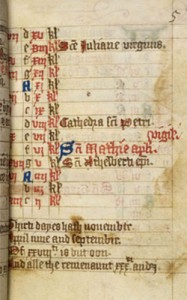Cé Mhéad Lá sa Mhí? (How Many Days in the Month?) Posted by róislín on Jan 20, 2012 in Irish Language
A reader recently posted a question about how to say how many days a month has. Bhuel, ar mhaith leatsa na bearnaí sa chairt seo a lionadh isteach ?
Oh, and dála an scéil, the months in this chart are not in chronological order. Don’t want it to be too much of a giveaway!
| Mí | Laethanta | |
| 1 | Bealtaine | |
| 2 | Deireadh Fómhair | |
| 3 | Feabhra | |
| 4 | Mí na Nollag | |
| 5 | Eanáir | |
| 6 | Márta | |
| 7 | Meitheamh | |
| 8 | Aibreán | |
| 9 | Mí na Samhna | |
| 10 | Lúnasa | |
| 11 | Meán Fómhair | |
| 12 | Iúil |
Leid:
Tá tríocha lá (30) ag ceithre mhí.
Tá lá is tríocha (31) ag seacht mí.
Tá ocht lá is fiche (28) ag mí amháin ach amháin i mbliain bhisigh nuair a bhíonn naoi lá is fiche (29) ag an mí seo.
For any given month, to say it has X number of days, the pattern is, “Tá X lá ag Eanáir.” As many of you will recognize, we’re not really using a verb that means “to have” here. Instead, we’re showing possession in the typical Irish way, saying the object is “at him” (at me, at her, etc.) using “aige” (agam, aici, srl.). So, for example, “September has 30 days” would be: Tá tríocha lá ag Meán Fómhair. Remember, the word for “day” stays singular (i.e. it remains as “lá”).
Is there any rhyme in Irish equivalent to “Thirty Days Hath September” in English? Bhuel, in fact, tá. But I don’t think it’s anywhere nearly as well known as the English “Thirty Days.” When I was in school, every child knew the English rhyme “Thirty Days,” it seemed. And I guess it gave us one of our early introductions to the history of the English language, if we stopped to think about it. To recite “Thirty Days Has September” (without the “hath”) just doesn’t have the same panache! That’s especially true when we consider that the rhyme goes back to the 15th century, when “hath” would have been the normal verb form.
But, lo and behold, there is an Irish equivalent to “Thirty Days,” published (and perhaps composed by) An tAthair Peadar Ua Laoghaire (1839-1920), an early Irish language activist, scholar, and writer. Slightly updated, to account for the spelling reform of the 1950s, it reads like this:
Na Laethanta i nGach Mí
(leis an Athair Peadar Ua Laoghaire, le litriú caighdeánaithe)
Tríocha lá a bheireann siad leo
Samhain, Aibreán, is na Mithimh teo.
Lá sa bhreis ag gach mí eile,
Ach an Feabhra thiar ar deireadh,
Gan aige ach ocht lá is fiche –
Naoi lá is fiche sa bhliain bhisigh.
Of course, this isn’t literally an equivalent to “Thirty Days.” For one thing, you can see that there are only three names listed as having thirty days: Samhain, Aibreán, and na Mithimh. The key thing is “na Mithimh” actually represent two separate months, the middle month of summer (June) and the middle month of Autumn (September). In Irish, summer (samhradh) traditionally means May, June, and July, and Autumn (Fómhar) is August, September, and October. The spring had March as a middle month and December was the middle month of winter. “Mithimh” could refer to all the middle months but only June and September would be part of “na Mithimh teo” (the warm middle months). “Teo” is the plural form of “te” (hot, warm). The “mithimh” idea survives as the modern Irish word “Meitheamh” (June).
Very literally, this version means:
Thirty days they take with them / November, April, and the hot middle months
A day extra at each other month / But February left back at the end,
With only eight days and twenty [even more literally: with only 8 days and 20 at him]
Nine and twenty in the increase-year [leap year].
And if anyone would like a rhyming (and hopefully catchy) translation of Ua Laoghaire’s version in English, I can offer this adaptation. Loosely translated, like poetry usually is. Of course, I’d really recommend learning the Irish version, but, hey, there’s no reason not to have more rhymes!
The Days of the Months
(translated by Róislín, based on the poem by an tAthair Peadar Ua Laoghaire)
Thirty days have these all,
November, April, mid-summer, mid-fall,
The other months have one day more
But February is two days poor
With 28, three years in four,
But leap year gives it one day more.
For more on the history of the leagan Béarla of this rhyme, you might want to check out this recent article by Rachael Misstear, http://www.walesonline.co.uk/news/need-to-read/2012/01/16/welsh-author-digs-deep-to-find-medieval-origins-of-thirty-days-hath-verse-91466-30128447/. Iontach suimiúil, nach ea! SGF, Róislín
Freagraí don chairt: 1. Bealtaine, May, 31; 2. Deireadh Fómhair, October, 31; 3. Feabhra, February, 28/29; 4. Mí na Nollag, December 31; 5. Eanáir, January, 31; 6. Márta, March, 31; 7. Meitheamh, June, 30; 8. Aibreán, April, 30; 9. Mí na Samhna, November, 30; 10. Lúnasa, August, 31; 11. Meán Fómhair, September, 30; 12. Iúil, July 31

Build vocabulary, practice pronunciation, and more with Transparent Language Online. Available anytime, anywhere, on any device.






Leave a comment: